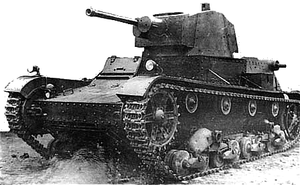Battle of Tomaszow Lubelski
| Battle of Tomaszów Lubelski | |||||||
|---|---|---|---|---|---|---|---|
| Part of Invasion of Poland | |||||||
 A Polish 7TP tank; 22 of these tanks participated in the battle. |
|||||||
|
|||||||
| Belligerents | |||||||
|
|
|
||||||
| Commanders and leaders | |||||||
|
|
First Phase: |
||||||
| Strength | |||||||
| Unknown number of soldiers +200 tanks and AFVs |
First Phase: 39,000 soldiers 225 cannons |
||||||
| Casualties and losses | |||||||
| Unknown | Unknown | ||||||
First Phase:![]() Antoni Szylling
Antoni Szylling![]() Tadeusz Piskor
Tadeusz Piskor
First Phase:
Unknown number of soldiers
~80 tanks and tankettes
The Battle of Tomaszów Lubelski took place from 18 September to 20 September 1939 near the town of Tomaszów Lubelski. It was the second largest battle of the Invasion of Poland (Battle of Bzura was the largest) and also the largest tank battle of the campaign. It resulted in the surrender of Army Krakow on 20 Sept. 1939.
The battle can be divided into two phases - from 17 to 20 September and from 21 to 26 September. They are often referred to in Polish sources as the First and Second battle of Tomaszów, respectively.
In the first phase (also known as the First Battle of Tomaszów Lubelski), Polish forces, composed of Army Lublin and Army Kraków under general Tadeusz Piskor attempted to break through the German positions around Tomaszów towards the Romanian Bridgehead area. Both armies joined forces on September 15, in the area southwest of Frampol. Their road towards south was blocked, however, by two German corps - VIII Army Corps (around Biłgoraj), and by XXII Panzer Corps, consisting of 2nd Panzer Division and 4th Light Division (around Hrubieszów, Zamość and Tomaszów Lubelski). Polish forces, concentrated around Frampol, were surrounded by six to seven German divisions. Since neither Army Kraków, nor Army Lublin had any aircraft, general Antoni Szylling, commander of Army Kraków, decided to risk and attack the Germans, without knowing their real strength. He knew that panzer forces had already approached Rawa Ruska, and hoped that their units would be stretched along the road from Jarosław to Rawa. Polish forces included one of the largest Polish armored units of that time, the Warsaw Armoured Motorized Brigade, and Szyling, together with general Piskor, decided that the Warsaw Brigade would make a demonstration attack on Tomaszów, drawing the attention of the Germans. Joined Polish forces were made of five infantry divisions - 3rd, 21st, 22nd, 23rd, and 55th. Furthermore, they consisted of 1st Mountain Brigade, Kraków Cavalry Brigade, and Warsaw Armoured Motorized Brigade. However, after days of heavy fighting, Polish units were reduced to 30-50% of their original strength (except for the Armoured Brigade), lacking food, antitank ammunition, petrol and maps. Furthermore, communication between separate divisions was scarce, and they had no air support, which was a huge disadvantage, as they had no idea about movements and location of German forces.
...
Wikipedia
